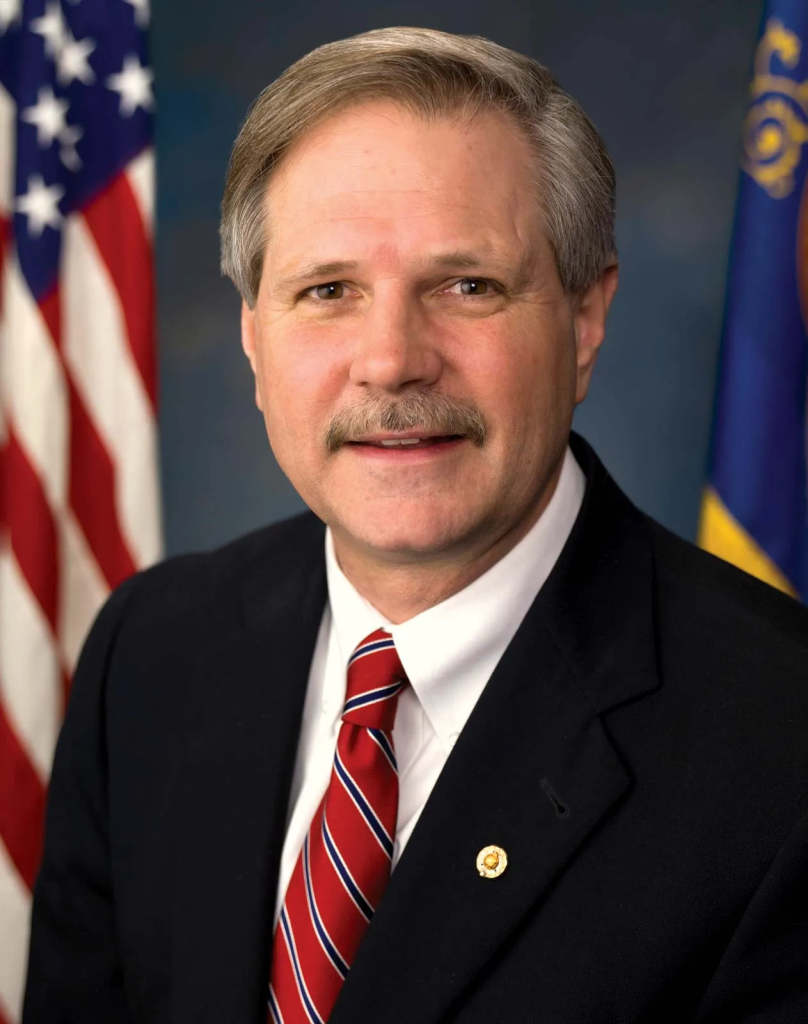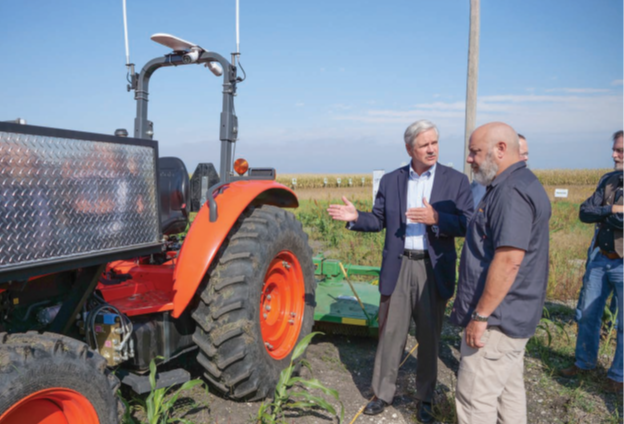
Americans enjoy the lowest cost, highest quality food supply in the world. On average, the people of this nation spend only 10 percent of their disposable income on food, which is a testament to the hard work of our farmers and ranchers. However, the events of recent years have shown that we cannot take our abundant and affordable food supply for granted. From potential food shortages due to the war in Ukraine and supply chain constraints, to the impact of record-high inflation on U.S. household budgets, it’s clear that the world needs an even greater abundance of high-quality American agricultural products to ensure a secure food supply. The good news is that North Dakota is already working to empower our farmers and ranchers to meet that need now and into the future.
Our state has long been a global leader in agriculture, but it used to be that you could grow only a few crops in western North Dakota. Through technological advancements and the development of new varieties of crops in recent decades, we have vastly expanded production agriculture in our state, which stands as the top U.S. producer in a variety of commodities, including spring and durum wheat, dry edible beans and peas, pinto beans, canola, flaxseed and honey.
At the same time, North Dakota soybean and corn production has expanded by a combined 3 million acres over the previous decade, an increase of 36 percent overall, while also securing growth in value-added agriculture, including biofuel production. Such developments have not only strengthened the farm economy and our food supply but coincided with the rapid development of our state’s oil and gas industry, enhancing North Dakota’s role as both a global agriculture and energy powerhouse.
The success of North Dakota agriculture is a strong example of the overall trends in the U.S., where farm productivity grew by nearly 300 percent between 1948 and 2017, despite farm inputs, such as fuel and fertilizer costs, remaining mostly level across this time frame. In order to maintain such dramatic progress, we need to advance the next frontier of farming and ranching. That’s exactly what precision agriculture technologies will help accomplish.
Precision Agriculture
Precision agriculture is a collection of innovations, such as autonomous vehicles, remote sensing, satellite imagery, mobile applications and unmanned aerial systems (UAS). These advancements give farmers and ranchers the real-time information and capabilities required to form more effective plans, streamline their operations, reduce their input costs and increase their yields.
Many of these technologies are already being adopted by agriculture producers, resulting in fewer hours working the fields and significantly reduced fertilizer, pesticide, water and fuel consumption. In fact, a majority of farmers already uses products such as auto guidance on their farm equipment and yield monitors in their fields, but there is plenty of headroom available for further progress using existing technologies. For instance, a 2021 study estimated that precision agriculture has resulted in a 4 percent and 9 percent decrease in agriculture water and herbicide usage, respectively, while estimating that there is potential for further reductions of 21 and 15 percent should these practices and technologies be fully adopted. In clearer terms, that represents an additional decrease of 2.4 million gallons of water and 48 million pounds of herbicide per year in the U.S., reducing costs to producers and consumers, as well as benefiting our water and soil resources.
Tech as the Third Wave
These estimates, while impressive, do not account for the innovations that are to come. That’s where we get back to the efforts underway in North Dakota. Following the expansion in agriculture and energy production in our state, we have experienced the rise of our state’s technology sector. Starting in my days as governor, we worked to build our state into a hub of technology entrepreneurship. We did so by creating the right kind of legal, tax and regulatory environment that encouraged investment and business formation, while leveraging our universities as engines of innovation.
As a result, technology is serving as the third wave in North Dakota’s economic growth, with technology subsectors contributing more than $3 billion to our state’s gross domestic product in 2020, up 39 percent from 2010.
Our UAS industry is a prime example of this success. North Dakota is a premiere location for unmanned aircraft research, development, training and operations. That’s due to the unique collection of public and private partners we’ve brought together, whether it’s federal, state and military agencies or businesses ranging from startups to multinational corporations. These collaborations are centered around the Northern Great Plains UAS Test Site and Grand Sky, a first-of-its-kind UAS technology and business park that is adjacent to the Grand Forks Air Force Base.
Through these partnerships, we are bringing to life new initiatives that reach across sectors, leading to developments far beyond our original vision. When we began building this industry in our state nearly 18 years ago, innovation meant getting unmanned aircraft into our domestic airspace. Now, we have built partnerships that reach all the way to space, tying our UAS industry to two missions that are essential to the future security of our nation, including a satellite mission with the Space Development Agency and Sky Range, a new hypersonic missile testing program based at Grand Sky.
Broadband
One important reason North Dakota has been able to sustain these exciting new developments is that we’ve worked to ensure our state has the capacity to support data-intensive operations. Unmanned vehicles, arrays of sensors and numerous other devices, involved in our tech industry, collect and transmit immense volumes of information, which require substantial broadband infrastructure to carry it all from the point of origin to the data servers and users. Again, this is another point where North Dakota is in a position of leadership.
According to U.S. News and World Report, our state is in the top five nationwide for access to gigabit internet service. Nearly 380 communities in our state, as well as surrounding rural regions, have access to gigabit broadband with a download speed of 1,000 megabits per second. For context, the Federal Communications Commission (FCC) defines broadband speed as a minimum download speed of 25 megabits per second. That means a large portion of our state has service that is 40 times faster than the federal definition, with almost all other North Dakotans having access to at least 100-megabit speeds.
This is the result of long-term efforts and investments to deploy this infrastructure to every corner of our state. In particular, Dakota Carrier Network (DCN) and its owner companies have built out 65,000 miles of fiber optic cable to serve as the backbone for internet service statewide. Such an undertaking required the forethought and hard work of broadband providers throughout the state, as well as the support of federal, state and local governments to make sure project developers had regulatory certainty, as well as access to the necessary capital.
Grand Farm
Now with these pieces in place, we’re bringing the same approach from Grand Sky and our UAS industry to precision agriculture. Grand Farm, a project led by Emerging Prairie, seeks to develop and demonstrate the next generation of precision agriculture. This organization has made tremendous strides in pulling together important partners, such as Microsoft, CHS, Doosan Bobcat, RDO Equipment Co., DCN and the North Dakota Department of Commerce, to name a few, to support this endeavor. Moreover, we’ve worked with Grand Farm and North Dakota State University to establish and fund, through the regular appropriations process, a $1-million cooperative agreement with the Agricultural Research Service (ARC) to enhance the research undertaken by this initiative, which has just reached a key milestone.

Grand Farm recently broke ground on a new 140-acre site near Casselton, North Dakota, where an Innovation Facility will be developed. Here, the project partners will be able to research, rapidly prototype and deploy new agriculture technologies. Construction began in October 2022, and projects are expected to begin deploying in spring 2023, marking the beginning of an exciting time for North Dakota agriculture producers, who are positioned to remain on the cutting-edge of new technology, enabling them to continue competing in the global marketplace.
With a dynamic technology sector, an established leadership in production agriculture, broadly accessible high-speed internet infrastructure and innovative collaborations like Grand Farm, North Dakota has a substantial head start in advancing the future of precision agriculture technologies. Ultimately, this benefits every American because it will help ensure continued access to the most reliable and affordable food supply in the history of the world. Throughout it all, we cannot take such a central aspect of our quality of life for granted. These things don’t just happen—it’s up to the many partners across the state, most importantly our farmers and ranchers who are working every day to ensure that food security will continue to be in place for years to come.
Senator Hoeven Working to Expand North Dakota Broadband Access As the lead Republican on the Senate Agriculture Appropriations Committee, Senator Hoeven advanced the following priorities to help move the efforts of North Dakota’s broadband providers forward by: • Establishing the ReConnect Program, a rural broadband loan and grant pilot program at the U.S. Department of Agriculture, which has provided critical support to our state’s broadband providers. • Passing legislation that will provide a minimum of $100 million over five years to North Dakota for further broadband expansion. • Cosponsoring and passing legislation to: - Identify and measure gaps in the availability of broadband on agricultural land, as well as develop recommendations to promote the rapid, expanded deployment of fixed and mobile broadband to unserved areas. - Improve federal broadband mapping by making the FCC’s data more granular, including more state, local and tribal government data, and establishing a challenge process to ensure the accuracy of data provided by Internet Service Providers. Supporting Grand Farm and Precision Agriculture • Securing $1 million to establish a cooperative agreement between Grand Farm, NDSU and USDA’s ARC. • Bringing USDA Secretary Sonny Perdue to North Dakota to learn about the Grand Farm initiative firsthand. • Inviting Grand Farm Director Brian Carroll to testify at a hearing of the Senate Agriculture Appropriations Committee on strengthening rural economies. • Looking forward, provided $4 million for precision ag research in Fiscal Year 2023 Agriculture Appropriations.
John Hoeven, United States Senator for North Dakota
The Honorable John Hoeven currently serves as North Dakota’s 22nd U.S. Senator, after serving as the state’s governor for 10 years. As governor, Hoeven worked to build North Dakota’s future by focusing on six pillars of growth: education, economic development, agriculture, energy, quality of life and technology. Under his leadership, the state greatly expanded and diversified its economy. Now, as a member of the U.S. Senate, Hoeven continues his efforts to build a pro-growth business climate; support Science, Technology, Engineering and Mathematics (STEM) education; and strengthen the state as a hub of technology entrepreneurship. These efforts have brought about a third wave in North Dakota’s economic growth with the rise of its technology sector. High-tech companies, both startups and multinational corporations, have taken root across North Dakota, developing new innovations to tackle global challenges in a wide range of sectors.
